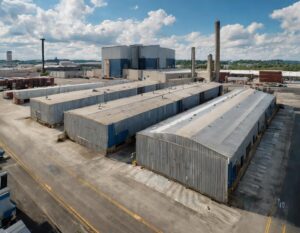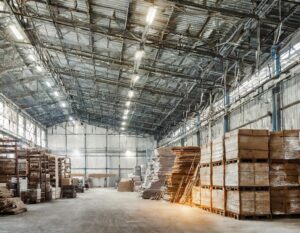- Market Slowdown: In the first half of 2023, Atlanta’s industrial market experienced a slowdown with tightened vacancies and decreased leasing activity due to move-outs and layoffs in the distribution sector.
- Supply and Demand Dynamics: A record wave of new supply began to deliver, coinciding with softening preleasing activities, indicating a market normalization rather than a downturn.
- Vacancy Trends: Despite rising vacancies over four consecutive quarters and the first negative absorption in three years by Q2 2023, the vacancy rate remained historically low at around 4.6%.
- Supply Impact Analysis: Even with 20 million square feet of unleased, under-construction space, the projected vacancy rate would only return to 2015, pointing to manageable supply concerns.
- Challenges in Large-Bay Spaces: There is an expected increase in vacancies, particularly in industrial spaces over 250,000 square feet, especially in exurban areas along the I-75 corridor.
- Small-Bay Space Scarcity: In contrast, a structural shortage of small-bay spaces in infill locations will keep these areas with low availability.
- Adaptive Reuse and Industry Demand: Adaptive reuse projects and the growing film industry drive demand and reduce inventory in closer locations.
- Strong Assets: Properties near Hartsfield-Jackson International Airport and key interstate junctions continue to see significant rent increases, though growth is leveling.
- Market Affordability: Despite slowing rent growth, Atlanta remains one of the U.S.’s least expensive major industrial markets.
- Future Market Fundamentals: The challenging financing environment, leading to reduced construction starts since mid-2022, is expected to contribute to tighter vacancies and more stable rent growth by late 2024 and 2025.
Page Contents
- Atlanta’s Industrial Vacancy
- Sublease and Inventory Challenges
- Impending Supply Increase
- Demand Diversification
- Vacancy Rate Trends
- Atlanta as a Logistics Center
- Sublease Market Dynamics
- Supply Surge and Market Impact
- Industrial Demand and Economic Growth
- Industrial Supply Wave in Atlanta
- Evolution of Industrial Developments
- Focus on Large-Scale Constructions
- Challenges in Kennesaw/Acworth
- Demand Dynamics in Southern Submarkets
- Industrial Investment Trends in Atlanta
- Price Dynamics and Market Response
- Impact of Tighter Credit on Transactions
- Redevelopment Focus on Older Assets
- Future Investment Outlook
- Final Thoughts
Atlanta’s Industrial Vacancy
The vacancy rate rose in early 2023 but remained low, noted by CoStar. Slower leasing and more buildings caused this. Leasing fell but still tops pre-pandemic levels. The rate is below the 10-year average.
Atlanta’s position as a logistics hub supports its industrial market. Links to major ports and cities drive demand. Significant leases show its strength despite economic shifts. Yet, retail changes and homebuilding declines affect it.
 Sublease and Inventory Challenges
Sublease and Inventory ChallengesSublease space grew as retailers adjusted. American Building Supply and Amazon released large areas. This increased sublease availability, showing the market strain. Rising subleases reflect retailers’ inventory issues.
As sublease offerings rise, so does vacancy. This reflects broader economic impacts. The trend might shift market dynamics. Atlanta’s industrial landscape adapts to these changes.
Impending Supply Increase
New constructions will raise vacancy rates. Over 70% of the upcoming 29.1 million SF is unleased. Larger spaces face more vacancies. Midsize properties are most affected.
Supply growth may pressure vacancies. This trend could alter the market balance, especially in more significant properties. This adjustment period is key for future dynamics. Watching these shifts is essential for investors.
Demand Diversification
Manufacturing growth could boost industrial demand. Investments in high-tech and automotive sectors are promising. New facilities around Atlanta highlight this trend. These projects could invigorate local industrial markets.
Atlanta reaps benefits from new investments in manufacturing. These developments could sustain long-term demand. The city’s industrial sector may see varied demand sources. This economic diversity supports market resilience.
Vacancy Rate Trends
In early 2023, Atlanta’s industrial vacancy rose but stayed below the 10-year average. Slower leasing and new buildings contributed. Leasing dropped yet exceeded pre-COVID levels.
The increase in Atlanta’s vacancy rate signifies a market adjustment rather than a decline. This adjustment reflects a balance between supply and demand, maintaining a solid market despite fluctuations.
Atlanta as a Logistics Center
Atlanta’s strategic location boosts its role as a logistics hub. Major leases affirm this despite economic shifts affecting spending. The region’s growth supports the industrial sector.
The connectivity and economic growth in the Southeast enhance Atlanta’s industrial market. These factors, combined with significant leases, illustrate the city’s enduring appeal in the logistics and distribution sectors.
Sublease Market Dynamics
Sublease space grew due to retail adjustments, with significant areas released for sublet. This increase highlights challenges in the retail sector and its impact on industrial spaces.
The rise in sublease availability in Atlanta reflects broader retail sector challenges. As companies adjust to market conditions, the industrial sector must adapt, influencing space demand and occupancy rates.
Supply Surge and Market Impact
An upcoming surge in supply, primarily unleased, may increase vacancies. Larger spaces will see more availability, impacting the market unevenly.
The expected influx of new industrial space in Atlanta could reshape the market, particularly affecting more significant properties. This development calls for strategic responses from investors and operators to manage the evolving landscape.
 Industrial Demand and Economic Growth
Industrial Demand and Economic GrowthManufacturing growth and new investments in the Southeast could enhance industrial demand. Notable projects near Atlanta highlight the region’s economic expansion and industrial potential.
Significant investments in manufacturing and technology are positioning Atlanta’s industrial market for growth. These developments create jobs and stimulate demand for industrial spaces, shaping the market’s future trajectory.
Industrial Supply Wave in Atlanta
Atlanta’s industrial construction remains high, with 29.1 million SF underway. This volume ranks Atlanta in the top national tier for supply. Most of this space is speculative and unleased.
The sustained construction boom in Atlanta reflects a strong market optimism despite a notable percentage of speculative projects. The city’s ability to maintain high construction levels underscores its strategic importance in the industrial sector.
Evolution of Industrial Developments
New Atlanta warehouses are larger and taller, with heights reaching 40 feet. Post-2010 buildings average over 200,000 SF, outpacing older, smaller facilities. This shift meets modern distribution needs.
The trend towards larger, more efficient spaces in Atlanta’s industrial sector reflects evolving logistics demands. As businesses seek expansive warehouses, Atlanta’s market adapts, offering more sophisticated options to meet these needs.
Focus on Large-Scale Constructions
Atlanta targets big-box industrial projects, easing the shortage of large buildings. Despite growing construction, the average lease size is shrinking. This could affect market fundamentals, particularly in areas with heavy supply.
The construction of large industrial facilities in Atlanta is a strategic move to address a specific market gap. However, the mismatch between supply and leasing trends necessitates careful monitoring to balance the market dynamics.
Challenges in Kennesaw/Acworth
Kennesaw/Acworth faces high vacancy despite good logistics links. A significant amount of new construction still needs to be unleashed. This area exemplifies the risks of overbuilding in less demanded submarkets.
In Kennesaw/Acworth, despite logistical advantages, the current high vacancy rate highlights the challenges of aligning construction with market demand. This scenario calls for strategic planning to optimize occupancy rates.
Demand Dynamics in Southern Submarkets
Southern Atlanta’s smaller buildings in high-demand areas contrast larger, unleased properties. These areas show diverse market dynamics, benefiting from proximity to population centers.
The southern part of Atlanta’s industrial market demonstrates a split in demand, where smaller, well-located properties thrive, unlike their larger counterparts. This indicates a nuanced market requiring tailored strategies for different submarket conditions.
Industrial Investment Trends in Atlanta
Atlanta’s industrial market sees high investment but slowed sales in early 2023. Large deals, like Prologis and Duke Realty, dominated recent activity. Sales volume reduction reflects broader economic influences.
Despite a slowdown in transactions, Atlanta remains a focal point for industrial investment, driven by significant deals. This trend suggests a cautious but sustained interest in the market, highlighting its strategic importance.
Price Dynamics and Market Response
Economic factors have stalled price appreciation in Atlanta’s industrial sector. Despite growth, prices remain below the national average. Market adjustments reflect the changing economic landscape.
The stalling of price appreciation in Atlanta indicates a market recalibration in response to broader economic shifts. This change may affect investment strategies, focusing on long-term value rather than immediate gains.
Impact of Tighter Credit on Transactions
Credit market tightening has affected the buyer landscape, causing a reassessment of cap rates. Low-leverage institutional buyers, however, continue to purchase, showing a divide in buyer expectations and market realities.
The differing strategies of buyers in Atlanta’s industrial market illustrate a nuanced investment environment. While some pursue aggressive acquisitions, others are more cautious, leading to a diverse transaction landscape.
Redevelopment Focus on Older Assets
Older industrial assets in Atlanta are prime targets for redevelopment, especially in central locations. Sales often aim more at land value, leading to demolition for new projects. This trend reflects a shift towards adaptive reuse and urban redevelopment.
The transformation of Atlanta’s older industrial spaces into new developments represents a significant shift in market dynamics. Investors are capitalizing on urban core properties, signaling a move towards modernization and adaptive reuse.
Future Investment Outlook
Investment in Atlanta’s industrial assets may stay muted amid uncertainties. Yet, institutional investors with long-term views keep targeting new, fully leased properties, indicating a selective but steady investment approach.
Despite uncertainties, the resilience of Atlanta’s industrial market shows a clear interest from institutional investors. Their focus on premium, stable assets suggests a strategic approach to navigating the current economic landscape.
Final Thoughts
In summary, Atlanta’s industrial market has seen varied investment trends and evolving property dynamics in 2023. Despite economic uncertainties, strategic opportunities remain for informed investors. Lumicre stands ready to assist with your investment needs, offering expertise in navigating this complex landscape. Contact Lumicre to explore how we can support your investment goals in Atlanta’s industrial sector.